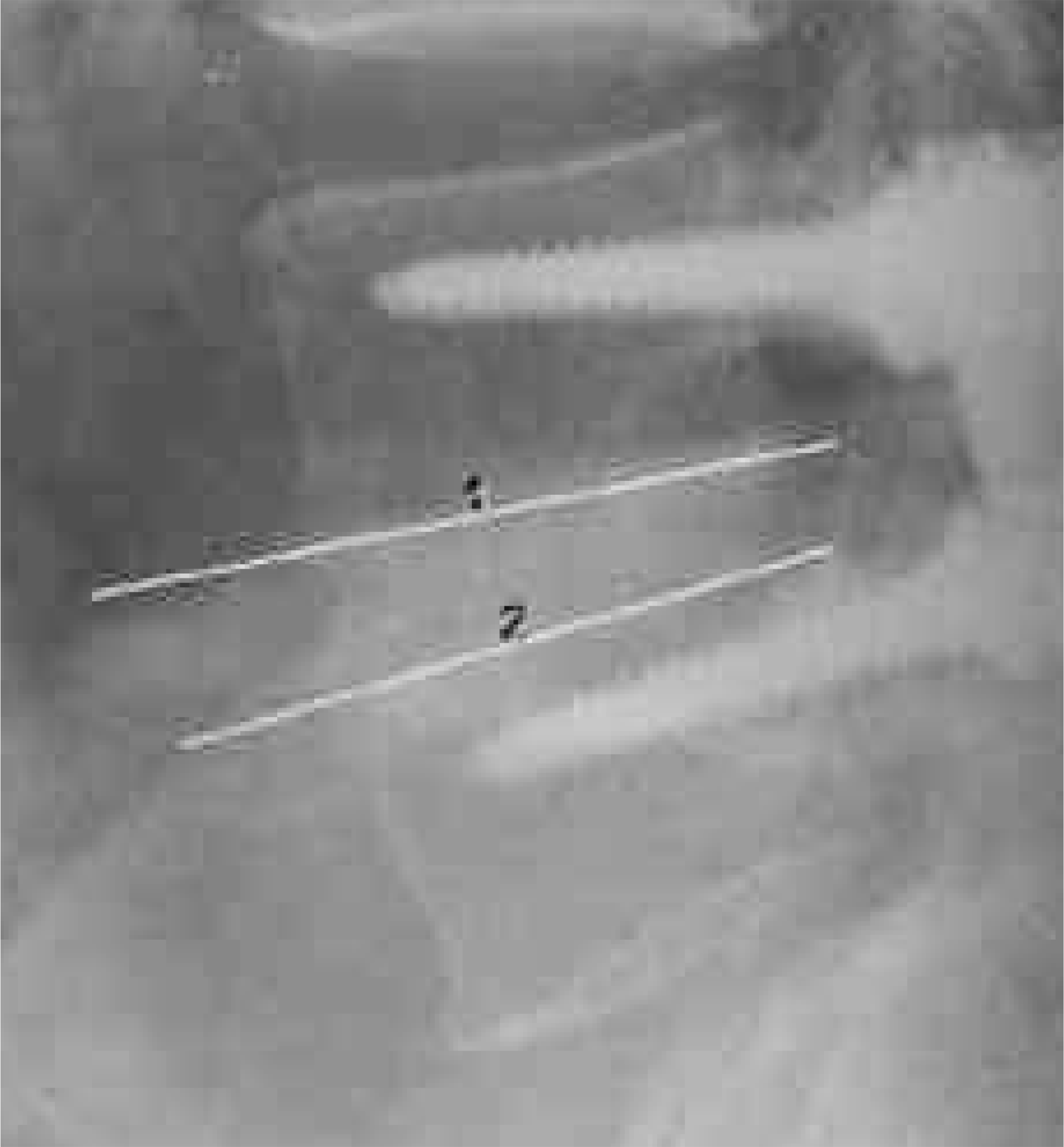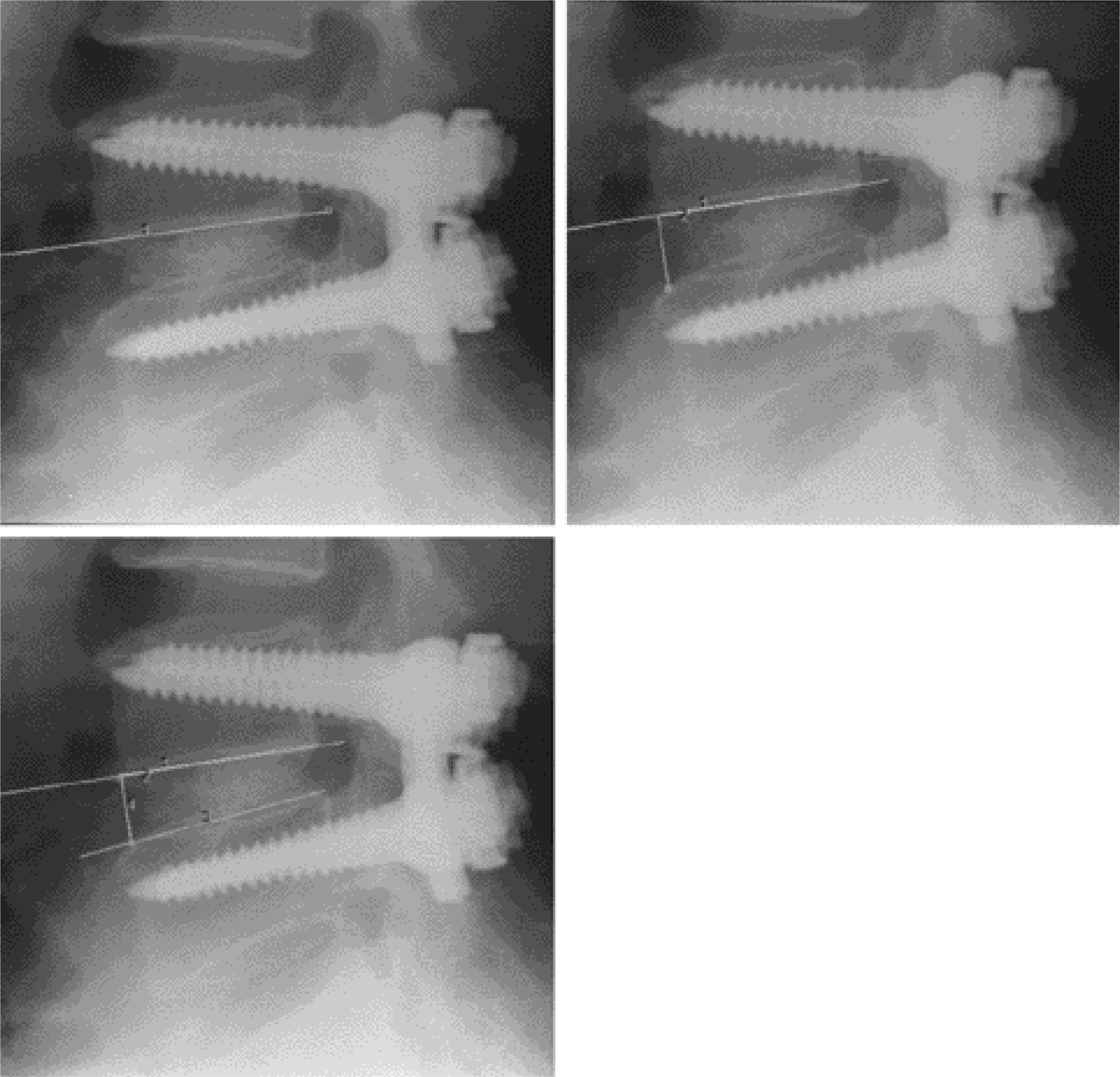Abstract
Objectives
This study compared the clinical results of the posterior lumbar interbody fusion (PLIF) using a cancellous allograft with the conventional autologous iliac bone graft.
Summary of Literature Review
The allograft is known to produce a similar effect as that of a nonvascular autogenous bone implantation. However, the implantation process occurs more slowly with the various degrees of the inflammatory reaction caused by the immunological reactions.
Materials and Methods
From June 1999 to February 2002, 39 patients were operated on by a single surgeon. There were 14 cases with 1 level, 4 cases with 2 levels posterior fusion with a cancellous allograft (objective group), and 20 cases with 1level and 1 case with 2 levels posterior fusion with a conventional bone graft (control group). The clinical results and standing lateral views of the lumbar spine were compared and analyzed in order to assess the fusion rate, the changes in the distance between the two vertebral bodies and changes in the lordotic angle formed between the fused bodies immediate after surgery and at the final followup.
Results
During the early postoperative period, the control group showed superior results. However, there were no significant differences between the two groups at the final followup. There were no statistically significant differences in the fusion rate, the changes in the intervertebral distance, and the lordotic angle.
Go to : 
REFERENCES
1). Brantigan JW, Steffe AD, Geiger JM. A carbon fiber implant to aid interbody lumbar fusion. Mechanical test ing. Spine. 1991; 16(6 Suppl):S277–82.
2). Ma GW. Posterior lumbar interbody fusion with special -ized instruments. Clin Orthip. 1985; 193:57–63.
3). Takeda M. Experience in posterior lumbar interbody fusion: Unicortical versus bicortical autologus grafts. Clin Orthop. 1985; 193:120–6.
4). Enker P Steffee AD. Interbody fusion and instrumentation. Clin Orthop. 1994; 300:90–101.
5). Lin PM. Posterior lumbar interbody fusion technique: Complications and fitfalls. Clin Orthop. 193:90–102. 1985.
7). Verlooy J, De Smedt K, Selosse P. Failure of a modified posterior lumbar interbody fusion technique to produce adequate pain relief in isthmic spondylolytic grade 1 spondylolisthesis patients. Spine. 1993; 18:1491–5.

8). Wimmer C, Krismer M, Gluch H, Ogon M, Stockl B. Autogenic versus allogenic bone grafts in anterior lumbar interbody fusion. Clin Orthop. 1999; 360:122–6.

9). Simmon JW. Posterior lumbar interbody fusion with posterior elements as chip graft. Clin Orthop. 1985; 193:85–89.
10). Pitzen T, Geisler FH, Matthis D, Muller-Storz H, Steudel WI. Motion of threaded cages in posterior lumbar interbody fusion. Eur Spine J. 2000; 9:571–6.

11). Gorlich Y, Lebek S, Reichel H. Substitution of tibial bony defects with allogeneic and autogeneic cancellous bone: Encouraging preliminary results in 18 knee replace -ments. Arch Orthop Trauma Surg. 1999; 119:220–2.
12). Leopold SS, Jacobs JJ, Rosenberg AG. Cancellous allograft in revision total hip arthroplasty. A clinical review. Clin Orthop. 2000; 371:86–97.
13). Bendo JA, Spivak JM, Neuwirth MG, Chung P. Use of the anterior interbody fresh-frozen femoral head allograft in circumferential lumbar fusions. J Spinal Disord. 2000; 13:144–9.

14). Liljenqvist U, O’ Brien JP, Renton P. Simultaneous combined anterior and posterior lumbar fusion with femoral cortical allograft. Eur Spine J. 1998; 7:125–31.

15). Wang JS, Tagil M, Aspenberg P. Load-bearing increases new bone formation in impacted and morselized allografts. Clin Orthop. 2000; 378:274–81.

16). Kozak JA, Heilman AE, O’ Brien JP. Anterior lumbar fusion options. Technique and graft materials. Clin Orthop. 1994; 300:45–51.

18). Tullberg T, Brandt B, Rydberg J, Fritzell P. F usi on rate after posterior lumbar interbody fusion with carbon fiber implant: 1-year followup of 51 patients. Eur Spine J. 1996; 5:178–82.
19). Bauer TW, Muschler GF. Bone graft materials. An overview of the basic science. Clin Orthop. 2000; 371:10–27.
20). Friedlaender GE. Bone grafts. The basic science ratio -nale for clinical applications. J Bone Joint Surg Am. 1987; 69:786–90.
Go to : 
Figures and Tables%
 | Fig. 1.Lordotic angle measures the angle between the lower end plate of the upper lumbar body and upper end plate of the lower lumbar body, which underwent fusion. |
 | Fig. 2.(A) Drawing a line along the lower endplate of the upper lumbar body. (B) A line perpendicular to the lower endplate of the upper lumbar body is drawn at the anterior end. (C) The distance of the perpendicular line drawn between the lower border of the upper lumbar body and the upper end plate of the lower lumbar body is measured. |




 PDF
PDF ePub
ePub Citation
Citation Print
Print


 XML Download
XML Download